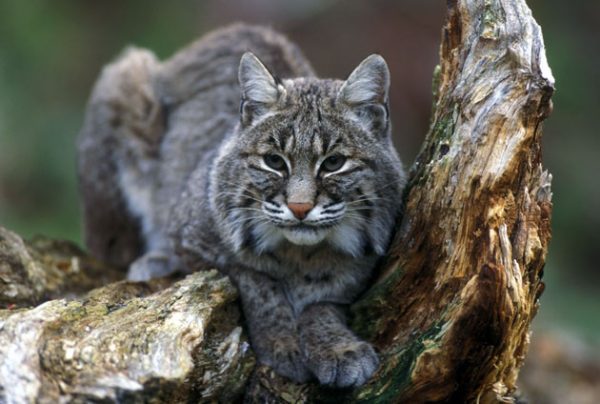Big cats in the Uwharries

I’ll admit it – I was a little delirious. The first day of summer year before last, I was out at first light, pacing the driveway and cradling our elderly Jack Russell in my arms. He’d been in a slow decline for months, but when he took a sudden turn for the worse, I knew I had to bring him home to die. I doped him up on pain medication for the five-hour drive from Atlanta to the Uwharries, but when that initial dose wore off in the night, he refused to take any more. He was inconsolable – restless and whimpering – but it helped to walk him around outside. I held him and waited, counting the minutes until the vet would arrive at her office.
In the diffuse grey light, a movement caught my eye. An animal stepped from a stand of native, warm-season grass and crossed the driveway just outside the gate, not 10 yards away. It was in no hurry, and my addled brain struggled to process the details of what I witnessed. Big. Head. Ears. Cat. Bobcat. Tail. Long tail. Long tail? Bobcat? The facts did not compute – they wouldn’t coalesce into any reliable whole. The circuits in my brain were overloaded. I needed to focus on my boy. I buried Buster that evening, the first day of a brutal heat wave. I laid him to rest in a corner of the yard next to the pasture where he had once broken a tether and chased a dozen head of cattle, and where that mysterious cat had stepped from the grass.
A few months later, I was in the yard with my binoculars, looking for fall migrants in the golden evening light. I came around the corner of the house and saw a large cat lounging in a patch of fescue Dad keeps mowed just outside the fence, in the spot where rabbits often frolic at sunset. I was about 50 feet away. I pulled up short, held my breath, and raised my binoculars, trying to memorize as many details as I could. The fur fanned away from the face and neck in shades of warm gray, charcoal and rusty brown. It was much, much larger than the feral house cats we see on occasion. When I reached into my pocket for my camera, the cat looked around and got to its feet, but it didn’t seem especially alarmed. As it sauntered into the taller grass, I was riveted by its size and its exceptionally long tail. I swear, I believe it would’ve dragged the ground if the cat hadn’t carried it crooked at the end like a question mark. It was ringed with light and dark stripes.
I knew this was the cat I had seen on Buster’s last morning. I rushed in and consulted my field guides. Nothing seemed exactly right. Juvenile panther? Large bobcat with a mutant tail? I began to wonder if a bobcat could cross with a panther. When I shared my story with friends and family members, I heard their stories in return. A guy from Ophir had seen a strange cat along the banks of the Uwharrie while he was paddling the river. A local hunter had captured an image of a large creature with the vertical slits of a cat’s pupils on his trail cam. Several people mentioned the infamous “black panther” said to stalk our woods.
I consulted several wildlife biologists, and they all agreed the bobcat (Lynx rufus) – our only native cat in the Uwharries – can be larger and have longer tails than is sometimes reported in field guides. While exceedingly rare, they can sometimes have a melanistic phase that produces a black coat, but a black specimen of our native panther (Puma concolor) has never been documented in North America. Also known as mountain lions, catamounts, cougars and pumas, these cats are fairly common out West. In recent years, they’ve increased in numbers and expanded their range. Young males often stray far from home, but experts say there’s no indication any of them are passing through our state on a regular basis, let alone taking up residence here. A small sub-population, the Florida panther, hangs on in the southern tip of the Sunshine State, but sadly, the eastern cougar was declared extinct several years ago.
Alas, if we cross paths with a large cat in the Uwharries, it’s likely an exotic pet that was released or escaped, not a native animal. That said, the chance of a panther someday finding a home among our forested hills seems far more likely than the possibility of Bigfoot ever turning up in our woods. In the meantime, I feel lucky to have had those two encounters with the normally elusive bobcat, especially one with such a crazy tail.
For more on this topic, see the blog posted last fall by Brad Howard of the N.C. Wildlife Resources Commission. http://www.ncwildlife.org/News/Blogs/NCWRCBlog/tabid/715/EntryId/129/The-Legendary-Cat-of-the-Mountains-and-the-Swamps-is-Just-That-a-Legend.aspx